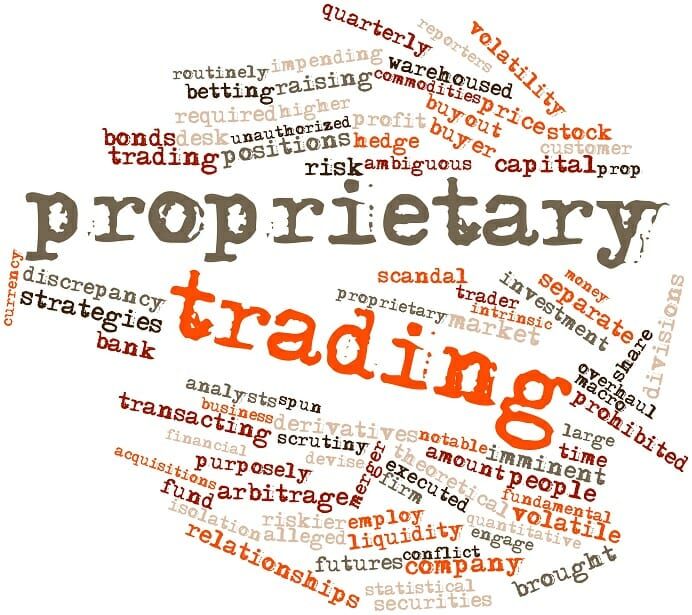Did you know that some traders consider proprietary trading and funded accounts like comparing apples to oranges—both are fruits, but they certainly don’t taste the same? In this article, we delve into the key differences between proprietary trading and funded accounts, two popular trading models with distinct characteristics. Discover what proprietary trading entails, how it differs from other trading types, and the inner workings of proprietary trading firms. We’ll explore the goals of proprietary traders and the requirements for funded accounts, including risk management strategies and capital allocation. Additionally, we’ll highlight the advantages and challenges of each approach, as well as qualifications, costs, and profit-sharing mechanisms. Whether you’re considering a switch between the two or simply want to enhance your trading knowledge, this guide from DayTradingBusiness has you covered.
What is proprietary trading?
Proprietary trading involves a firm trading its own money to make profits, not clients’ funds. It aims for quick gains through buying and selling securities, derivatives, or commodities. Unlike funded accounts, where traders use clients' or investors' capital, proprietary trading uses the firm’s capital directly. The goal is to generate high returns internally, often with advanced strategies and high leverage.
How does proprietary trading differ from other trading types?
Proprietary trading involves firms using their own money to trade for profit, not clients’ funds. Funded accounts, on the other hand, are trading accounts provided to traders by firms, where traders use the firm’s capital but share profits. Proprietary trading gives traders full control over trades and strategies, with the firm taking all risk. Funded accounts limit traders’ risk to predefined parameters set by the firm, often with profit splits. The key difference is ownership: proprietary traders trade the firm’s money directly, while funded traders operate with the firm’s capital but retain more structured risk management.
What are funded trading accounts?
Funded trading accounts are accounts provided by firms that supply traders with capital to trade, sharing profits and losses. Traders use this capital without risking their own money. Unlike proprietary trading, where traders trade the firm's own funds, funded accounts are externally financed by third-party companies. These accounts often involve evaluation phases or challenges to qualify for the funding. The main difference is that funded accounts are externally sponsored, while proprietary trading involves the firm’s own capital.
How do proprietary trading firms operate?
Proprietary trading firms operate by using their own capital to trade financial markets, aiming to generate profits directly. They hire traders or develop algorithms, providing them with capital, technology, and risk management tools. Unlike funded accounts, they don’t rely on outside investors; all gains and losses stay with the firm. These firms often have strict trading strategies and performance targets, and traders typically share a percentage of profits. Their goal is to leverage the firm’s capital efficiently while managing risk tightly.
What are the main goals of proprietary traders?
Proprietary traders aim to generate profits for their firm by trading stocks, options, or other financial instruments using the firm's capital. They focus on exploiting market opportunities, managing risks effectively, and maximizing returns quickly. Their main goal is to earn consistent, high-frequency profits while adhering to risk limits set by the firm.
What are the typical requirements for funded accounts?
Funded accounts usually require passing a trading evaluation, demonstrating consistent profitability, and managing risk within specified limits. They often need a verified trading history, adherence to rules, and sometimes a fee or deposit to access the capital.
How does risk management differ in proprietary vs. funded trading?
Risk management in proprietary trading involves the firm setting strict limits on position sizes, daily losses, and leverage to protect its own capital. Traders are often given specific risk parameters and are directly accountable for losses. In funded trading, risk management relies on the rules set by the funding company, who controls the capital and enforces strict drawdown limits, often with more oversight and predefined risk thresholds. Funded traders follow these strict guidelines, with the company managing overall risk exposure, while proprietary traders have more autonomy but are still bound by firm policies.
What are the advantages of proprietary trading?

Proprietary trading offers firms the chance to maximize profits directly from market moves without client constraints. It allows traders to use the firm’s capital, enabling larger positions and potentially higher returns. Proprietary trading also gives traders more flexibility and control over their strategies, fostering innovation and quick decision-making. Additionally, it can provide access to advanced tools and resources that enhance trading performance.
What benefits do funded accounts offer traders?
Funded accounts give traders access to capital without risking their own money, allowing larger trades and potential profits. They often come with fewer personal financial risks, faster scaling of trading size, and access to professional trading environments. This setup also provides opportunities for traders to prove their skills and earn consistent funding, which can lead to long-term trading careers.
How is capital allocated in proprietary trading?
In proprietary trading, capital is allocated directly from the firm's own funds to traders, who use it to execute trades aiming for profit. The firm determines the amount of capital each trader receives based on their experience, track record, and risk management strategy. Traders have access to the firm's capital but must adhere to risk limits set by the firm. Any profits or losses directly impact the firm's capital pool.
What are the common challenges in proprietary trading?

Common challenges in proprietary trading include managing high risk exposure, maintaining consistent profitability, staying ahead of market volatility, and handling intense competition. Traders often struggle with emotional discipline, adapting quickly to market changes, and controlling leverage to avoid large losses.
How do traders qualify for funded accounts?
Traders qualify for funded accounts by proving consistent profitability during evaluation phases, meeting specific profit targets, risk limits, and trading rules set by the funding firm. They often need to demonstrate discipline, proper risk management, and the ability to sustain profitability over a set period.
What are the costs involved in proprietary trading?
Proprietary trading costs include capital risk, trading platform fees, research expenses, and regulatory compliance costs. You also face potential losses on trades and the need for skilled traders. Unlike funded accounts, where costs are often limited to platform fees and profit sharing, proprietary trading involves significant financial risk and operational expenses.
Can you switch between proprietary and funded trading?
Yes, you can switch between proprietary trading and funded accounts. Proprietary trading involves trading firm’s own capital, while funded accounts mean trading with someone else’s money, usually after passing evaluation challenges. Transitioning depends on the firm's policies; some firms allow movement from one to the other after meeting their criteria.
How do profit sharing and payouts work in both models?

In proprietary trading, firms share a portion of the profits with traders, often based on a pre-agreed split, after deducting trading costs. Payouts happen regularly, reflecting trading performance, and traders typically keep a percentage of gains. In funded accounts, traders receive capital from the firm and earn a fixed percentage of profits, usually after meeting specific trading objectives or risk management rules. Payouts are made periodically, based on the profits generated within the funded account, with the firm retaining the rest.
What are the risks associated with proprietary trading?
Risks of proprietary trading include significant financial losses if trades go wrong, potential conflicts of interest that may lead to unethical behavior, and increased exposure to market volatility. It also involves high pressure to generate quick profits, which can lead to reckless decision-making.
How do trading strategies differ between proprietary and funded accounts?
Proprietary trading involves traders using the firm’s own money, giving them free rein to develop strategies without external restrictions. Funded accounts, however, provide traders with capital from a third-party company after they prove their skills, often with strict risk limits and performance targets. In proprietary trading, traders typically have more flexibility and higher risk tolerance, while funded accounts enforce rules to protect the capital, focusing on consistency and risk management.
Learn about How Do Institutional Trading Strategies Differ from Individual Trading?
Conclusion about What Are the Differences Between Proprietary Trading and Funded Accounts?
In summary, proprietary trading and funded accounts present distinct opportunities and challenges for traders. Proprietary trading allows firms to leverage their own capital, focusing on high-risk, high-reward strategies, while funded accounts enable traders to access capital with specific requirements and risk management protocols. Understanding these differences is crucial for making informed decisions in your trading journey. For comprehensive insights and support, consider exploring resources from DayTradingBusiness to enhance your trading skills and strategies.
Sources:
- Volcker Rule & Proprietary Trading
- Prohibitions and Restrictions on Proprietary Trading and Certain ...
- Frequently Asked Questions - Federal Reserve Board
- The Volcker Rule and Market-Making in Times of Stress
- Payment methods and the disposition effect: Evidence from ...
- Order aggressiveness of institutional and individual investors ...